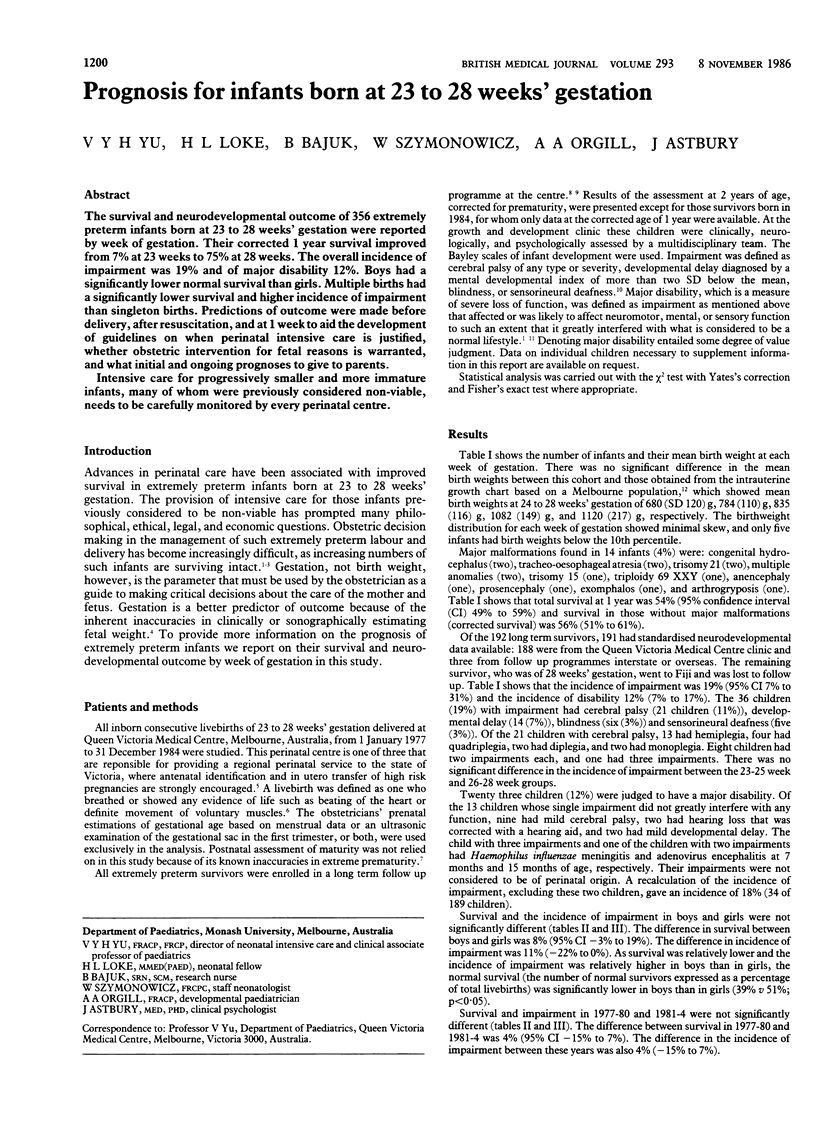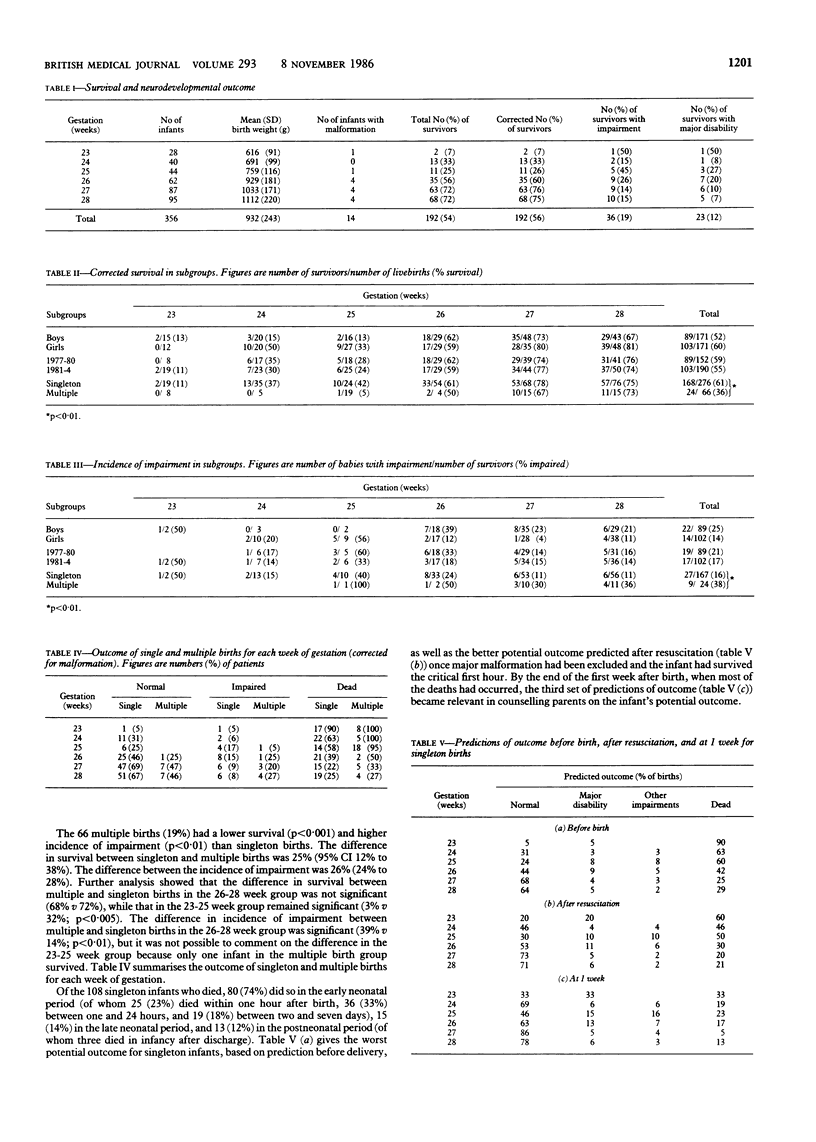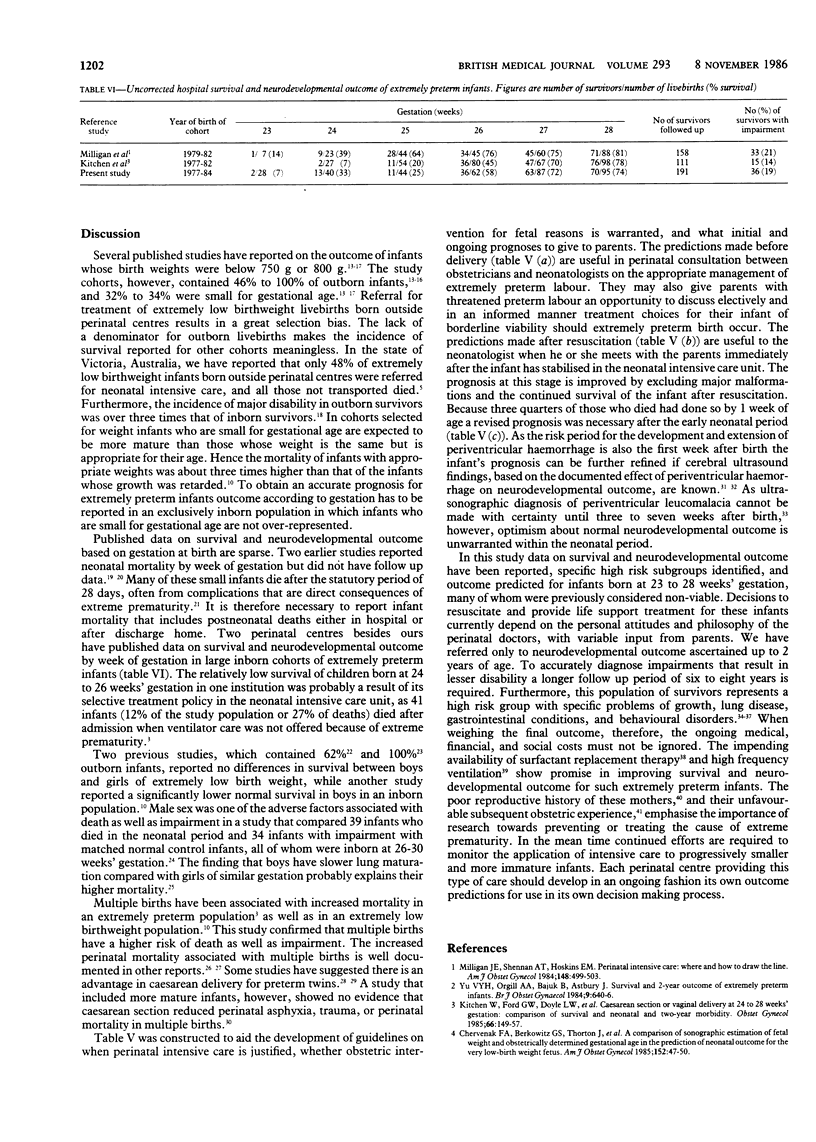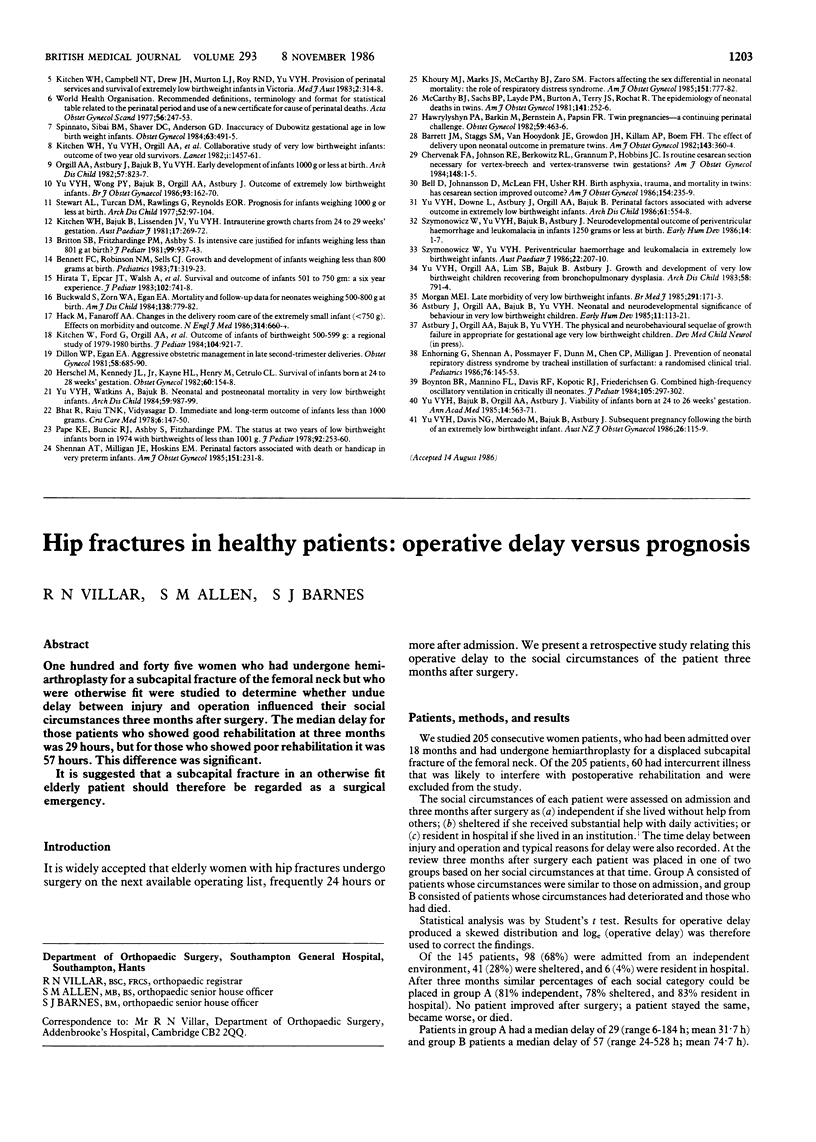Abstract
The survival and neurodevelopmental outcome of 356 extremely preterm infants born at 23 to 28 weeks' gestation were reported by week of gestation. Their corrected 1 year survival improved from 7% at 23 weeks to 75% at 28 weeks. The overall incidence of impairment was 19% and of major disability 12%. Boys had a significantly lower normal survival than girls. Multiple births had a significantly lower survival and higher incidence of impairment than singleton births. Predictions of outcome were made before delivery, after resuscitation, and at 1 week to aid the development of guidelines on when perinatal intensive care is justified, whether obstetric intervention for fetal reasons is warranted, and what initial and ongoing prognoses to give to parents. Intensive care for progressively smaller and more immature infants, many of whom were previously considered non-viable, needs to be carefully monitored by every perinatal centre.
Full text
PDF



Selected References
These references are in PubMed. This may not be the complete list of references from this article.
- Barrett J. M., Staggs S. M., Van Hooydonk J. E., Growdon J. H., Killam A. P., Boehm F. H. The effect of type of delivery upon neonatal outcome in premature twins. Am J Obstet Gynecol. 1982 Jun 1;143(3):360–367. doi: 10.1016/0002-9378(82)90825-0. [DOI] [PubMed] [Google Scholar]
- Bell D., Johansson D., McLean F. H., Usher R. H. Birth asphyxia, trauma, and mortality in twins: has cesarean section improved outcome? Am J Obstet Gynecol. 1986 Feb;154(2):235–239. doi: 10.1016/0002-9378(86)90646-0. [DOI] [PubMed] [Google Scholar]
- Bennett F. C., Robinson N. M., Sells C. J. Growth and development of infants weighing less than 800 grams at birth. Pediatrics. 1983 Mar;71(3):319–323. [PubMed] [Google Scholar]
- Bhat R., Raju T. N., Vidyasagar D. Immediate and long-term outcome of infants less than 1000 grams. Crit Care Med. 1978 May-Jun;6(3):147–150. doi: 10.1097/00003246-197805000-00005. [DOI] [PubMed] [Google Scholar]
- Boynton B. R., Mannino F. L., Davis R. F., Kopotic R. J., Friederichsen G. Combined high-frequency oscillatory ventilation and intermittent mandatory ventilation in critically ill neonates. J Pediatr. 1984 Aug;105(2):297–302. doi: 10.1016/s0022-3476(84)80136-5. [DOI] [PubMed] [Google Scholar]
- Britton S. B., Fitzhardinge P. M., Ashby S. Is intensive care justified for infants weighing less than 801 gm at birth? J Pediatr. 1981 Dec;99(6):937–943. doi: 10.1016/s0022-3476(81)80028-5. [DOI] [PubMed] [Google Scholar]
- Buckwald S., Zorn W. A., Egan E. A. Mortality and follow-up data for neonates weighing 500 to 800 g at birth. Am J Dis Child. 1984 Aug;138(8):779–782. doi: 10.1001/archpedi.1984.02140460069023. [DOI] [PubMed] [Google Scholar]
- Chervenak F. A., Berkowitz G. S., Thornton J., Kreiss C., Youcha S., Ehrenkranz R. A., Hobbins J. C., Berkowitz R. L. A comparison of sonographic estimation of fetal weight and obstetrically determined gestational age in the prediction of neonatal outcome for the very low-birth weight fetus. Am J Obstet Gynecol. 1985 May 1;152(1):47–50. doi: 10.1016/s0002-9378(85)80175-7. [DOI] [PubMed] [Google Scholar]
- Chervenak F. A., Johnson R. E., Berkowitz R. L., Grannum P., Hobbins J. C. Is routine cesarean section necessary for vertex-breech and vertex-transverse twin gestations? Am J Obstet Gynecol. 1984 Jan 1;148(1):1–5. doi: 10.1016/s0002-9378(84)80022-8. [DOI] [PubMed] [Google Scholar]
- Dillon W. P., Egan E. A. Aggressive obstetric management in late second-trimester deliveries. Obstet Gynecol. 1981 Dec;58(6):685–690. [PubMed] [Google Scholar]
- Enhorning G., Shennan A., Possmayer F., Dunn M., Chen C. P., Milligan J. Prevention of neonatal respiratory distress syndrome by tracheal instillation of surfactant: a randomized clinical trial. Pediatrics. 1985 Aug;76(2):145–153. [PubMed] [Google Scholar]
- Hack M., Fanaroff A. A. Changes in the delivery room care of the extremely small infant (less than 750 g). Effects on morbidity and outcome. N Engl J Med. 1986 Mar 6;314(10):660–664. doi: 10.1056/NEJM198603063141036. [DOI] [PubMed] [Google Scholar]
- Hawrylyshyn P. A., Barkin M., Bernstein A., Papsin F. R. Twin pregnancies--a continuing perinatal challenge. Obstet Gynecol. 1982 Apr;59(4):463–466. [PubMed] [Google Scholar]
- Herschel M., Kennedy J. L., Jr, Kayne H. L., Henry M., Cetrulo C. L. Survival of infants born at 24 to 28 weeks' gestation. Obstet Gynecol. 1982 Aug;60(2):154–158. [PubMed] [Google Scholar]
- Hirata T., Epcar J. T., Walsh A., Mednick J., Harris M., McGinnis M. S., Sehring S., Papedo G. Survival and outcome of infants 501 to 750 gm: a six-year experience. J Pediatr. 1983 May;102(5):741–748. doi: 10.1016/s0022-3476(83)80250-9. [DOI] [PubMed] [Google Scholar]
- Imogen Morgan M. E. Late morbidity of very low birthweight infants. Br Med J (Clin Res Ed) 1985 Jul 20;291(6489):171–173. doi: 10.1136/bmj.291.6489.171. [DOI] [PMC free article] [PubMed] [Google Scholar]
- Khoury M. J., Marks J. S., McCarthy B. J., Zaro S. M. Factors affecting the sex differential in neonatal mortality: the role of respiratory distress syndrome. Am J Obstet Gynecol. 1985 Mar 15;151(6):777–782. doi: 10.1016/0002-9378(85)90518-6. [DOI] [PubMed] [Google Scholar]
- Kitchen W. H., Bajuk B., Lissenden J. V., Yu V. Y. Intrauterine growth charts from 24 to 29 weeks' gestation. Aust Paediatr J. 1981 Dec;17(4):269–272. doi: 10.1111/j.1440-1754.1981.tb01956.x. [DOI] [PubMed] [Google Scholar]
- Kitchen W. H., Campbell N., Drew J. H., Murton L. J., Roy R. N., Yu V. Y. Provision of perinatal services and survival of extremely low birthweight infants in Victoria. Med J Aust. 1983 Oct 1;2(7):314–318. doi: 10.5694/j.1326-5377.1983.tb122487.x. [DOI] [PubMed] [Google Scholar]
- Kitchen W. H., Yu V. Y., Orgill A., Ford G. W., Rickards A., Astbury J., Ryan M. M., Russo W., Lissenden J. V., Bajuk B. Collaborative study of very-low-birthweight infants: Outcome of two-year-old survivors. Lancet. 1982 Jun 26;1(8287):1457–1460. doi: 10.1016/s0140-6736(82)92464-3. [DOI] [PubMed] [Google Scholar]
- Kitchen W., Ford G. W., Doyle L. W., Rickards A. L., Lissenden J. V., Pepperell R. J., Duke J. E. Cesarean section or vaginal delivery at 24 to 28 weeks' gestation: comparison of survival and neonatal and two-year morbidity. Obstet Gynecol. 1985 Aug;66(2):149–157. [PubMed] [Google Scholar]
- Kitchen W., Ford G., Orgill A., Rickards A., Astbury J., Lissenden J., Bajuk B., Yu V., Drew J., Campbell N. Outcome in infants with birth weight 500 to 999 gm: a regional study of 1979 and 1980 births. J Pediatr. 1984 Jun;104(6):921–927. doi: 10.1016/s0022-3476(84)80500-4. [DOI] [PubMed] [Google Scholar]
- McCarthy B. J., Sachs B. P., Layde P. M., Burton A., Terry J. S., Rochat R. The epidemiology of neonatal death in twins. Am J Obstet Gynecol. 1981 Oct 1;141(3):252–256. doi: 10.1016/s0002-9378(16)32628-x. [DOI] [PubMed] [Google Scholar]
- Milligan J. E., Shennan A. T., Hoskins E. M. Perinatal intensive care: where and how to draw the line. Am J Obstet Gynecol. 1984 Mar 1;148(5):499–503. doi: 10.1016/0002-9378(84)90734-8. [DOI] [PubMed] [Google Scholar]
- Orgill A. A., Astbury J., Bajuk B., Yu V. Y. Early development of infants 1000 g or less at birth. Arch Dis Child. 1982 Nov;57(11):823–827. doi: 10.1136/adc.57.11.823. [DOI] [PMC free article] [PubMed] [Google Scholar]
- Pape K. E., Buncic R. J., Ashby S., Fitzhardinge P. M. The status at two years of low-birth-weight infants born in 1974 with birth weights of less than 1,001 gm. J Pediatr. 1978 Feb;92(2):253–260. doi: 10.1016/s0022-3476(78)80020-1. [DOI] [PubMed] [Google Scholar]
- Shennan A. T., Milligan J. E., Hoskins E. M. Perinatal factors associated with death or handicap in very preterm infants. Am J Obstet Gynecol. 1985 Jan 15;151(2):231–238. doi: 10.1016/0002-9378(85)90019-5. [DOI] [PubMed] [Google Scholar]
- Spinnato J. A., Sibai B. M., Shaver D. C., Anderson G. D. Inaccuracy of Dubowitz gestational age in low birth weight infants. Obstet Gynecol. 1984 Apr;63(4):491–495. [PubMed] [Google Scholar]
- Stewart A. L., Turcan D. M., Rawlings G., Reynolds E. O. Prognosis for infants weighing 1000 g or less at birth. Arch Dis Child. 1977 Feb;52(2):97–104. doi: 10.1136/adc.52.2.97. [DOI] [PMC free article] [PubMed] [Google Scholar]
- Szymonowicz W., Yu V. Y., Bajuk B., Astbury J. Neurodevelopmental outcome of periventricular haemorrhage and leukomalacia in infants 1250 g or less at birth. Early Hum Dev. 1986 Jul;14(1):1–7. doi: 10.1016/0378-3782(86)90164-7. [DOI] [PubMed] [Google Scholar]
- Yu V. Y., Bajuk B., Orgill A. A., Astbury J. Viability of infants born at 24 to 26 weeks gestation. Ann Acad Med Singapore. 1985 Oct;14(4):563–571. [PubMed] [Google Scholar]
- Yu V. Y., Davis N. G., Mercado M. F., Bajuk B., Astbury J. Subsequent pregnancy following the birth of an extremely low birth-weight infant. Aust N Z J Obstet Gynaecol. 1986 May;26(2):115–119. doi: 10.1111/j.1479-828x.1986.tb01545.x. [DOI] [PubMed] [Google Scholar]
- Yu V. Y., Downe L., Astbury J., Bajuk B. Perinatal factors and adverse outcome in extremely low birthweight infants. Arch Dis Child. 1986 Jun;61(6):554–558. doi: 10.1136/adc.61.6.554. [DOI] [PMC free article] [PubMed] [Google Scholar]
- Yu V. Y., Watkins A., Bajuk B. Neonatal and postneonatal mortality in very low birthweight infants. Arch Dis Child. 1984 Oct;59(10):987–989. doi: 10.1136/adc.59.10.987. [DOI] [PMC free article] [PubMed] [Google Scholar]
- Yu V. Y., Wong P. Y., Bajuk B., Orgill A. A., Astbury J. Outcome of extremely-low-birthweight infants. Br J Obstet Gynaecol. 1986 Feb;93(2):162–170. doi: 10.1111/j.1471-0528.1986.tb07881.x. [DOI] [PubMed] [Google Scholar]


